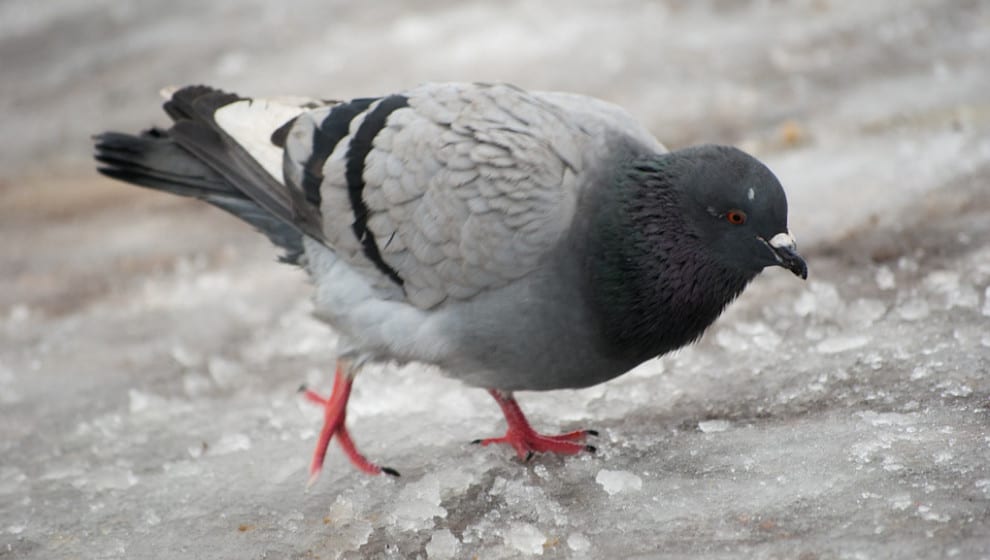Pigeons can be found from one side of the earth to the other and can tolerate a wide range of natural and climatic conditions. To be precise, the pigeons don’t know what temperature is too cold, and they can easily withstand sub-zero temperatures (Celsius).
Warm light or a warm cushion keeps them away and makes their feet frostbite. Try not to emphasize the chance of no one because their feathers will accumulate a lot of air, which will make them shockingly warm without paying little attention to the climate.
They are happy to fly around and bring our food variety in late spring, but what do they say when the weather is cold? Will the pigeons get cold? Is there a way to control a cold?
Table of Contents
Do Pigeons Feel The Cold?
Indeed, birds do feel cold, and those birds that cannot adapt to the environment will migrate. In spring, 29 types of summer travelers appear in the UK to raise their nestlings. At this time, as the fall blurs, they head to a hotter environment.
These include swallows, flycatchers, and feral cats. Indeed, when January is too cold to consider endurance, even the Blackbirds may head towards Eastern Europe.
Birds are warm-blooded animals and have a higher calorie-burning ability than humans, therefore having higher internal heat. Although specific estimates will vary from bird to bird, the internal heat of a typical bird is 105 degrees Fahrenheit (40 degrees Celsius).
Compared with larger birds, smaller birds dissipate heat faster because they have a relatively large body surface area and dissipate heat, but the heat-generating center has a smaller volume.
In the coldest climate, you can also see birds inhabiting, and at the same time, make yourself fluffy and leave a gap between the plumes to trap heat inside.
Can Pigeons Survive In Cold Weather?
Yes, birds can do survive in cold weather. Following these steps, it helps them in bearing the cold weather.
If you are a pigeon operator and live in an area where the temperature is beginning to drop, then you must find a way to protect your pet bird from the cruel cold brought by the colder time of the year. That is crucially important. The following few things to pay attention to, in the whole cold weather, you can never really keep the pigeons warm:
- Place the water bowl on a warm mat to prevent freezing.
- If you can’t heat the bird’s water, you should convert it three times every day anyway. Spotlights or warm lights get hot in the birdcage.
- It would help if you also put a warm cushion to prevent frostbite on the pigeon’s supporting feet. Cover the fence with clothes and plastic sheets in the evening feed them extra corn at twice the rate every day.
They can also spend time with different birds, mainly if the climate is messy. At any point, you notice that essentially the entirety of birds that stick around in colder times of year do as such in herds?
Having different birds around makes it more outlandish that something will eat you; more eyes = less possibility of a hunter sneaking up.
Also, if something sneaks up, you must be quicker than the person rummaging close to you! Additionally, different birds are acceptable at telling you where the primo food is and help them survive more in cold weather.
How Cold Is Too Cold For The Pigeon?
Pigeons can tolerate cold temperatures, but there is a limit to how much cold they can take. If pigeons are highly resistant to barbarous viruses as penguins and polar bears, then pigeons will survive in the cold.
No one can say how cold these birds are, but we can be sure that they can withstand temperatures as low as 40 degrees Fahrenheit quietly.
Do Pigeons Need Heat In The Winter?
To start with, local birds like greenfinches or sparrows. These are generally huge finches with thick quills, which imply they can hold heat well.
They do this by exploding quills to frame a protecting layer, now and then lying down with just one foot. Difference this with the plumes of birds, like Gouldian finch or Owl finch. These usually are more modest birds, yet their plumes are a lot more slender.
That implies that they have fewer plumes and can’t extend and protect themselves. That means that they are typically unfit to keep up their internal heat level because the regular habitat means that they don’t have to do as such.
How Can You Tell If A Bird Is Cold?
When it’s wet and cold outside, the human nose was running, and our throat hurts. A great many people need to manage cold or viral contamination eventually. Be that as it may, what might happens to a bird when they feel cold?
Will they contaminate comparable illnesses? How can pet proprietors respond when their quill companions are in the climate?
To be sure, a few birds contract bugs, even though they are not as defenseless to colds as people. Assuming this is the case, they regularly sniffle and have precise release or discharge in their noses.
German bird veterinarian Anja Petersen said that a few birds stick their snouts to high positions or pen bars more than once.
Symptomatic birds can be treated with infrared lamps. Peterson said that should always illuminate the cage from above, not from the side. Should cover one corner of the cell with a towel to form an area where the animal can retreat if it is too hot.
The chances are that there is no improvement following two days of infrared light treatment; the poultry ought to be taken to the veterinarian. The equivalent has valid on the off chance that you quit eating or drinking.
The primary driver of colds in poultry is extreme temperature vacillations. For instance, confines have typically positioned close to windows to give steady light. The warmth produced by the radiator, which has generally situated under the window, creates wind current, which advances colds.
Where Do Pigeons Go When Cold?
Have you ever notice at any point where the birds will go when it is cool, pouring, or even turbulent? That is an inquiry posed by many bird lovers.
The most famous bird that stays in your space during the coldest time of the year is your crew bird. These birds stay in one area all year long, paying little attention to the seasons.
During the coldest time of the year, different birds move into space, usually from the icy areas of Alaska and Canada. During the most challenging time of the year, you will constantly see these short-lived and resident birds on the bird feeder every day.
Check out these birds below to see where they go on every winter.
- Blue Jays: These cute birds will search for thick evergreen plants and rest in them in the winter. By hiding them between the leaves, they can protect themselves from the most terrible factors.
- Chickadees: These birds usually live alone in tree holes, bird boxes, and buildings. Another first choice is the perch bag that can purchase in many tool stores.
- Birds and pigeons temporarily rest as part of a medium-sized herd, usually in a huge coniferous tree. Compared with most birds, pigeons prefer to do on a horizontal shelf rather than on the habitat. That is why they like the edges of buildings, stable pillars, and the underside of extensions.
- Finch: On creepy cold days, it is well known that American goldfinch will burrow into the snow to form a resting hole. More often, they will shuttle among goldfinches on conifers on winter nights.
- Northern Cardinal: Like the Blue Jays, the Cardinal Church inhabits dense evergreens with other pigeons of the same type in the winter.
- Nuthatches: Most nuthatches will search for unused old woodpeckers to open their mouths for a good night’s sleep. They will gather in large numbers regularly, whether that means they need to get closer to each other.
- Starling birds will swarm in large numbers and roost in groups, though, in all winters. These social affairs often include a large number of birds. They pick a tree and choose it to stay on cold days.
- Titmice and wrens: The tufted Titmice and wrens out tree holes, but they also like to perch on their pockets. Those little “birdhouses” are perfect for a few tufted tits or widows to spread out in winters.
- Woodpeckers: As they do when assembling a home for the youthful, woodpeckers additionally stay in bed tree depressions in the colder time of year. On the off chance that they can’t track down a lovely spot, they will make their own.
- spend time with different birds or as in a group
Especially in a messy climate. Can you notice at any time that during the coldest time of the year, almost all the birds staying nearby are in groups? There are different birds around, making people even more uncertain that something will swallow you.
More eyes = less chance of hunters sneaking away. Besides, if something sneaks away, you must be faster than the people approaching you! Tell you where the original food is, and can also accept other birds.
How Do Pigeons Keep Warm In The Winter?
Regardless of how low the encompassing temperature is, birds have numerous approaches to adjust their bodies and practices to keep warm.
Physical Adaptation
Feathers
The plumes of birds give critical warmth protection to the virus. Numerous birds add additional plumes during the shedding in late pre-winter to provide them with thicker assurance in winter. The oil covering bird quills from bird urinary organs can likewise give protection and water obstruction.
Legs And Feet
A unique scale covers the legs and feet of the bird to limit heat misfortune. Birds can likewise control the portions and feet’ temperature by limiting the bloodstream in their appendages to isolate them from the body, in this manner diminishing warmth misfortune without frostbite.
Fat Reserves
- Even little birds can construct fat stores as extra energy for heat protection and body heat age. When food sources are bountiful, numerous birds will sink into gulches in pre-winter to furnish them with additional fat to lay egger before winter shows up.
Behavioral Adaptation
Fluff
The birds’ feathers have fluffed to form air pockets for additional insulation at low temperatures. That will make them look fat when baking.
Folds
It is not uncommon to see a bird standing on one leg or squatting down to cover the legs with feathers to protect the bare skin from the cold. Birds can also tuck banknotes into the feathers of their shoulders to protect the body and breathe air warmed by body heat.
Tanning
On sunny winter days, many birds use solar energy. They will face the sun with their backs (thus exposing the most prominent side of their bodies to the heat) and raise their feathers slightly. That allows the sun to heat the skin and feathers more effectively.
When tanning, the wings may droop or open, and the tail may open. The larger the surface area of the birds exposed to sunlight, the faster they heat up.
Shivering
Birds shake to expand their metabolic rate and produce more body heat. That is a quick answer for an outrageous virus. Shaking requires more calories; however, it is a compelling method to remain warm under extreme conditions, at any rate for the time being, or in regions where plentiful food sources are promptly accessible.
Roosting
Many little birds, including bluebirds, tits assemble in huge gatherings around evening time, in a restricted, limited space, to share body heat. They can occupy hedges or trees, and void poultry houses and bird perching boxes are additionally famous spots to preserve heat.
Indeed, even individual birds will pick natural surroundings that may create lingering heat because of the day’s daylight, for example, close to the storage compartment of a tree or near to any dull surface.
Can You Keep Pigeons Outside?
The rescued pigeons can’t fly securely (they are apparent objectives for birds and felines), so they should be ensured in an aviary when they are outside.
It should be hunter-safe (solid and immovably built, including top and base). Rat safe (utilize 16 check or better equipment network, openings of a large portion of an inch or less), and incorporate a protected corner to Keep it cool on the most sultry days and dry in stormy climate.
Nobody needs a more modest dovecote, so make it as extensive as could be expected. The base size of four birds is in any event 6 feet in length, 4 feet down, and 6 feet high.
Pigeons are acceptable at recreation and artistry. They invest energy in washing, preparing, hanging out in the sun, scrounging for their number one seeds, watching the sky, aping, flaunting, and pursuing.
Each four to five weeks, the mated couple will lay a couple of eggs (to control the conception, prevent the pigeons from supplanted by counterfeit eggs) and alternate between sitting on the eggs. The pigeon adores his family and accomplice.
They need new food and water each day, quick poop consistently, and intensive bird home cleaning each week. The pigeon is lovely, quiet, and brimming with character.
However long it requires some investment and energy, a great many people can subdue by hand. Everybody can be companions. It is not difficult to make a beautiful, appealing, and safe aviary for the rescued pigeons.
Conclusion
Need to help birds through the colder time of year? Consider giving high-energy food sources like suet, peanuts, and dark oil sunflower seeds. Water is irreplaceable consistently, so adding a warmed water basin can help keep the bird hydrated-simply make sure to keep the water clean!
You can give asylum to numerous species by introducing roosting boxes or leaving dead trees, which might be reasonable for birds that depend on tree openings. Planting organic product bearing trees and bushes can help draw in species like cedar finches-make sure to ensure you are planting local species. If it isn’t reasonable for strong trees, kindly think about planting evergreen plants!
Whatever you do, kindly recall that these little and sensitive birds depend on us to furnish them with the best everyday environments. Cushioned, debilitated birds are ordinarily making progress toward death. At this stage, fewer and fewer alternatives are accessible to help them; however, warming them initially can keep away from specific issues.

I am a primary writer, mom, and long-time cat parent. My two Russian Blues are the queens of my house. Cats are the most loved pet all over the world due to their cuddly gestures and cute looks. I always felt my soul has a deeper bond with animals, especially cats.
My work is to guide pet owners about their frequent queries about their beloved one pet. I have spent 10 years of my life working with hundreds of animal species. This passion for animal care and love gives me the courage to spread my words worldwide. My writings will help you to decide about the food, housing, and training of your pet.

